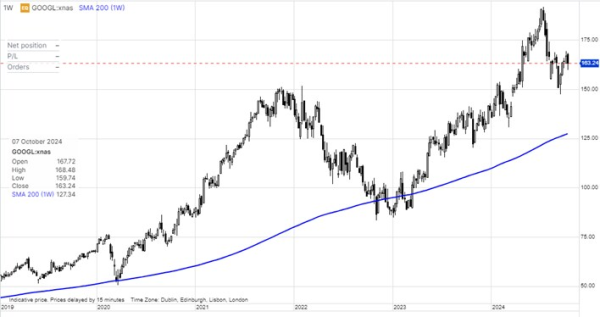US Election countdown: the best and worst scenarios for the market.
2024 US Election countdown. With only three weeks to go...
The polls this week say:
The oddsmakers this week say:

This week: The two election scenarios that will likely trigger the most immediately positive and negative market reactions.
The polls have shown further modest tightening for the presidential race, with Harris shrinking lead in the polls pointing to higher odds of a Trump win. Polls in the key seven battleground states are impossibly close and we seem almost guaranteed a nail-biting Election Night on November 5th.This week, we look at the two scenarios that would likely offer markets the clearest “playbook” for the road ahead, making them the most positive and negative of the possible outcomes for the market. Of course, all of this scenario analysis is untestable, as we will only get one outcome, but here goes…
The two election scenarios that could prove the most immediately negative on the one hand, and the most positive on the other are both scenarios involving a Harris victory for president. More on why below.
In the meantime, in any Harris victory scenario it’s important to consider an additional critical risk, one that is most urgent for the Mag 7 stocks: Would a Harris administration reappoint the avowed anti-monopolist Lina Khan as Chair of the Federal Trade Commission (FTC) when her term ends next year? While Khan has had limited success in taking on the monopolist companies she criticizes like Amazon, Meta and Google parent Alphabet, she is the strongest voice in Washington arguing that these companies need breaking up and has further major ambitions to do so. Harris has yet to reveal whether she will reappoint Khan. The outlook for Mag 7 stocks is always worth mentioning because these 7 stocks have a market value of over USD 16 trillion, making them worth more than all the stocks in the Japanese and Chinese stock markets combined. A failure to reappoint Khan would be a signal that the Democrats are prioritizing keeping their largest campaign donors happy rather than moving against these enormous and enormously influential info-tech monopolies on ideological grounds.
Chart of the week: Google’s fate linked to US regulators.

The most negative and most positive election outcome scenarios.
The long-term implications are immense for investors should the anti-monopoly forces one day succeed in breaking up or significantly disrupting the business model of Mag 7 stocks like Apple, Alphabet, Meta, Amazon, Microsoft and even Nvidia. But the timelines are very extended, probably years. With only three weeks to go until Election Day, the more immediate question is how the market will treat the election outcome the day after the election and in ensuing weeks. In the past few weeks we’ve covered the two most likely Trump scenarios: Trump 2.0 in which Trump both wins and the Republicans gain control of both houses of Congress, and “Trump gridlock” in which the Republicans only control the White House and Senate. On that latter scenario, the market may be badly underestimating the likelihood of that Trump gridlock outcome, as the Democrats might take control of the House in a close election. Polymarket.com only puts the odds of a Trump gridlock scenario at 13%, versus 38% odds for a Trump 2.0.Now let’s consider the two Harris scenarios and why they are so extremely different. The most immediately positive scenario for the market could be “Harris gridlock”, in which Harris wins the presidency, but the Democrats lose control of the Senate, even if they do win the House. This scenario is more or less the current market “status quo” that has brought us all time highs in stocks even before the election. While Harris winning means that US companies wouldn’t get fresh corporate tax cuts promised by Trump, it also means that the US economy would avoid Trump’s promised new hefty tariffs. Likewise, the Trump agenda would likely have been more USD positive, at least in the beginning, and a weaker US dollar more likely under Harris is better for global growth. The Harris gridlock scenario is priced in betting markets as the second most likely, currently 26% odds.
On the other hand, a Democratic sweep is the most obviously negative scenario for markets in the days after the election. This is very straightforward: The Democrats have promised to raise corporate taxes from 21% to 28% and the anticipation of higher tax rates would mean that company valuations would need a swift, one-off adjustment lower. Just as the very positive impact of Trump’s chopping the corporate tax rate from as high as 39% to a flat rate of 21% after the 2016 election, this could mean a sell-off of several percent or more in US stocks. A Democratic sweep scenario would be a huge surprise, given the current betting odds of around 18% (and this looks too high – the Senate election map is extremely difficult for the Democrats at this election. It should perhaps be 10% or lower odds).
See you next week!
About the author: John is Saxo’s Chief Macro Strategist, with over twenty-five years’ experience in the financial markets, chiefly as Saxo’s former Head of FX Strategy. He is also an American, having grown up in Houston, TX and has a long-standing passion for following the course of US elections and their place in history since being allowed to stay up late as a young kid to watch the 1980 election results roll in and Ronald Reagan winning the presidency over Jimmy Carter.